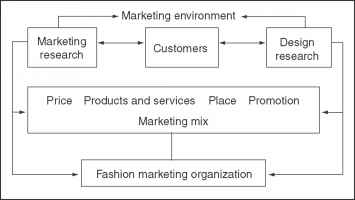An overview of the fashion marketing process
Fashion marketing can be viewed as a process and Figure 1.4 illustrates that process. It also gives an indication of the structure of this book and how various parts link together.
All firms operate within a wider commercial environment that influences their activities. Changes in value added tax may inhibit demand for certain garments whereas a fall in unemployment may stimulate demand for workwear. These two simple examples illustrate how changes in the marketing environment can have significant effects on the operation of fashion firms. The marketing environment and how to analyse it are covered in Chapter Two.
Central to the concept of fashion marketing is the role of the customer and Chapters Three and Four deal with understanding and researching the fashion purchaser. In Chapter Three the behaviour of consumers will be discussed. In particular, there will be an examination of the reasons why people buy particular garments: what influences them and what criteria they use. Clothing may be an expression of how people wish others to see them, it may denote membership

- Figure 1.4 The fashion marketing process.
a of a certain group or represent a particular lifestyle. To understand
0 customers' aspirations and expectations about clothing fully, relevant 3 psychological and sociological factors are examined in Chapter Three.
1 Chapter Four takes the understanding of customers' behaviour one t step further by looking at how data concerning this behaviour are J' obtained, namely marketing research. This research can also involve the study of competitors and analysis of the company's own marketing efforts.
In Figure 1.4 the term marketing mix is used to describe the combination of variables used by the fashion marketer to meet the needs of specific groups of customers known as target markets. The selection of target markets and the management of the marketing mix are discussed in Chapters Five to Ten of this book.
Here is an example of how a variable may be adjusted using an example concerning price. A firm may decide to charge low prices and sell large quantities making a small profit on each item, but a large profit in total. A consequence of charging low prices may be that certain outlets are selected because their image is compatible with low prices. The concept of the marketing mix and target marketing are dealt with in Chapter Five. The actual components of the marketing mix are known for the sake of simplicity as the four Ps, i.e. Price, Product, Place and Promotion, and these are covered in Chapters Six to Nine. The role of design research, integral to product design and development, is covered in Chapter Six.
Putting all aspects of the marketing mix together to achieve the goals of the organization is the most important marketing task. Activities must be planned, co-ordinated and implemented effectively, and the results monitored. The final chapter deals with fashion marketing planning.
Continue reading here: Size of the fashion market
Was this article helpful?
Readers' Questions
-
andreas1 year ago
- Reply
-
garfield1 year ago
- Reply